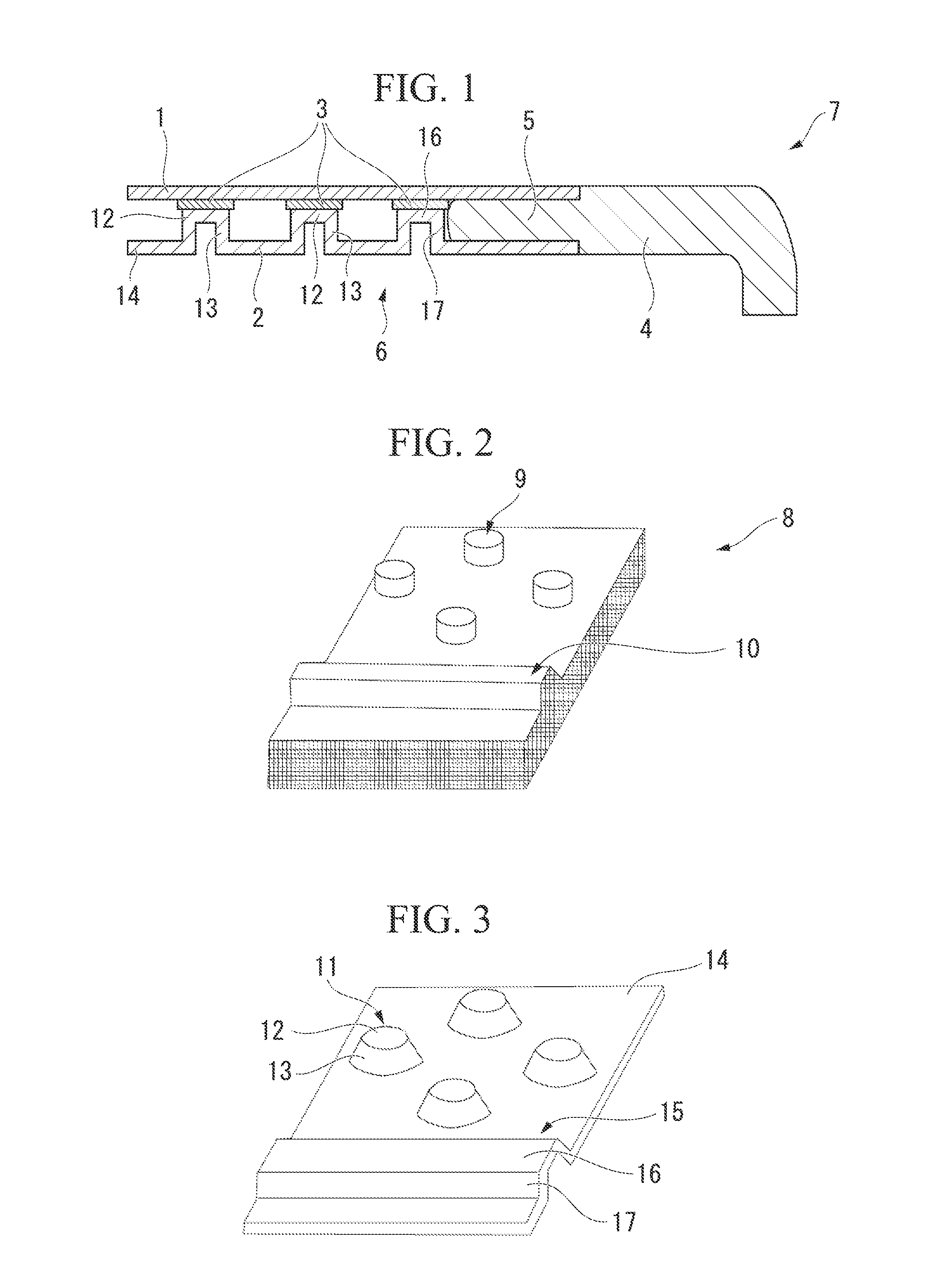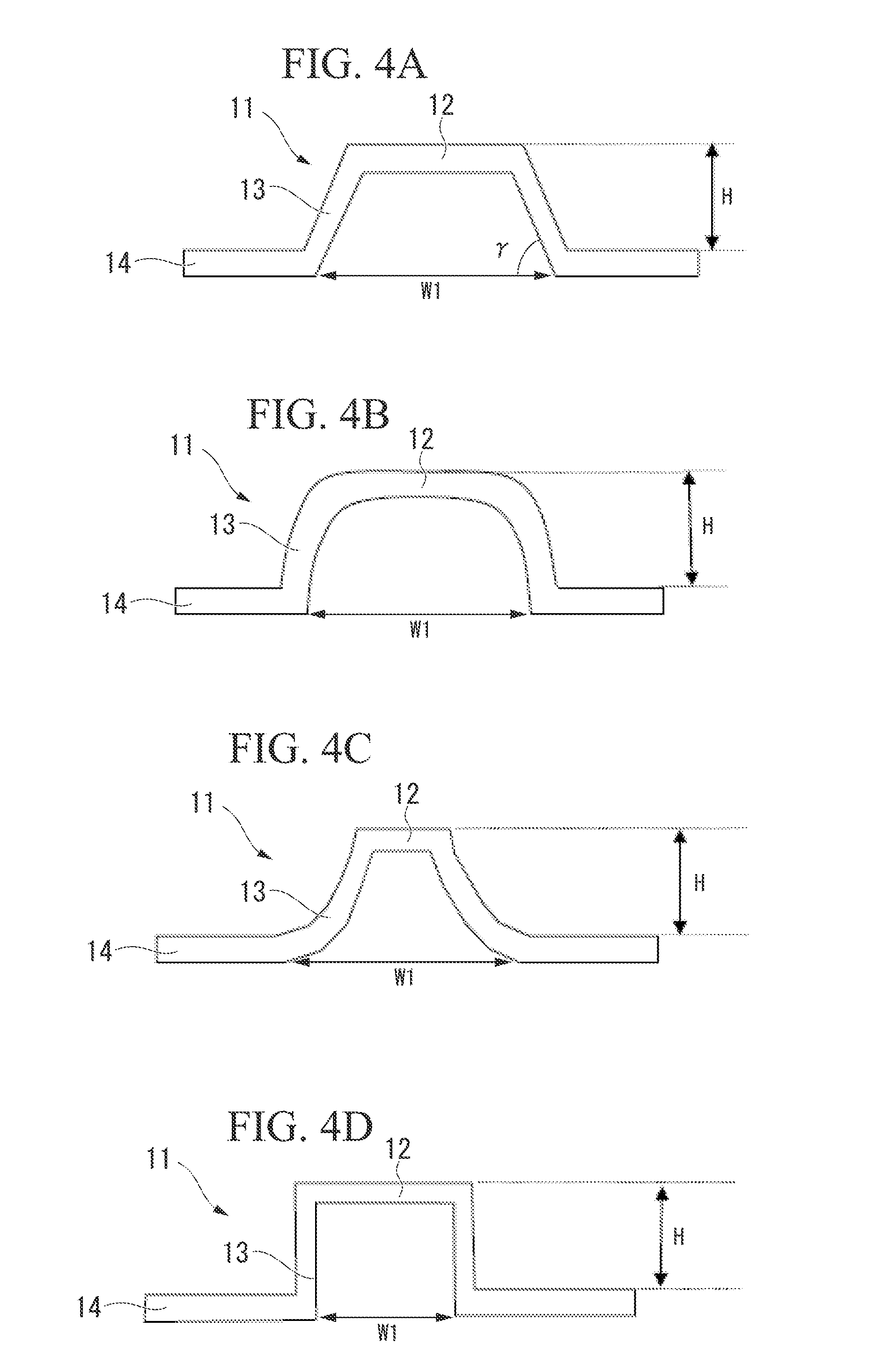Fiber reinforced composite material structure, composite material molded body using the same, and manufacturing method therefor
a composite material and fiber reinforced technology, applied in the direction of other domestic objects, woodworking apparatus, transportation and packaging, etc., can solve the problems of affecting the light weight property and thin thickness property of the product, affecting the appearance quality of the product, and affecting the light weight property and thin thickness property, so as to achieve sufficient rigidity, reduce the effect of weight and reduction of thickness
- Summary
- Abstract
- Description
- Claims
- Application Information
AI Technical Summary
Benefits of technology
Problems solved by technology
Method used
Image
Examples
example 1
[0123]In the example, a unidirectional prepreg manufactured by Mitsubishi Rayon Co., Ltd. and having a product name of TR390E125S (an epoxy resin #390 (manufactured by Mitsubishi Rayon Co., Ltd.) as a thermosetting resin and a carbon fiber as a reinforcing fiber (manufactured by Mitsubishi Rayon Co., Ltd. and having a product name of TR50S)) was used.
[0124]First, a laminate having the four layers of unidirectional prepreg (the unidirectional sheet) laminated at the angles of 0°, 90°, 90°, and 0° was disposed on the surface of the thin sheet lower die 8 including the protrusions to form the convex portions 11 of the thin sheet 2. Subsequently, the die was closed with the upper die having the recesses corresponding to the protrusions of the lower die 8, and the prepreg laminate was pressed for 5 minutes at the pressure of 8 MPa while being heated at 140° C. using the lower die 8 and the upper die so as to integrally cure the prepreg laminate. After the compression molding, the die was...
example 2
[0131]In the examples below, computer simulations were performed by referring to the result of Example 1.
[0132]“Femap with NX Nastran” was used as the simulation software, and the constrain condition was set as a simple support.
[0133]The thin sheet 2 and the surface material 1 of the example was molded in a manner such that a unidirectional prepreg manufactured by Mitsubishi Rayon Co., Ltd. and having a product name of TR390E125S (epoxy resin #390 (manufactured by Mitsubishi Rayon Co., Ltd.) as thermosetting resin and a carbon fiber (manufactured by Mitsubishi Rayon Co., Ltd. and having a product name of TR50S) as reinforcing fiber) was laminated as three layers as [0° / 90° / 0°], and the laminate was pressed and cured for 5 minutes at the pressure of 8 MPa while being heated at 140° C.
[0134]As the thin sheet 2, a molded sheet is used which has a longitudinal width of 200 mm and a lateral width of 300 mm and in which the columnar convex portions 11 each having a diameter of 5.0 mm are ...
example 3
[0138]The thickness and the weight of the structure of this example are set to be the same as those of the sandwich structure of Comparative Example 2. A structure having a thickness of 1.35 mm and a mass of 74.4 g is obtained by setting the height H of the columnar convex portions 11 to be 0.535 mm and setting the thickness of each of the layers forming the laminate to be 0.119 mm using the same method as Example 2.
[0139]The maximum bending displacement becomes 2.98 mm by the same bending test of the structures that of Example 2. Here, the bending displacement and the rigidity are the same as those of Comparative Example 2.
PUM
| Property | Measurement | Unit |
|---|---|---|
| overlap length | aaaaa | aaaaa |
| angle | aaaaa | aaaaa |
| angle | aaaaa | aaaaa |
Abstract
Description
Claims
Application Information
 Login to View More
Login to View More - R&D
- Intellectual Property
- Life Sciences
- Materials
- Tech Scout
- Unparalleled Data Quality
- Higher Quality Content
- 60% Fewer Hallucinations
Browse by: Latest US Patents, China's latest patents, Technical Efficacy Thesaurus, Application Domain, Technology Topic, Popular Technical Reports.
© 2025 PatSnap. All rights reserved.Legal|Privacy policy|Modern Slavery Act Transparency Statement|Sitemap|About US| Contact US: help@patsnap.com



